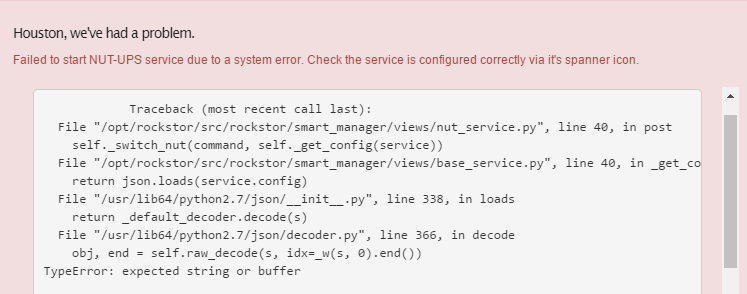@glenngould Hello again and thanks for the update:
that’s great news, glad to hear it.
The directions at http://networkupstools.org are often based on a ‘from source’ install but pretty much all linux distributions package NUT and so it’s binaries will not be placed in /usr/local. Rockstor, being based on CentOS, simply uses the prepackaged NUT binaries included with CentOS which as you guessed are elsewhere. To run the command you mention you can simply omit the path, then the packaged installed binary will be called:
upsc ups@localhost ups.status
And given yours is a standalone config (locally connected UPS) you can omit the “@localhost”:
upsc ups ups.status
or better still you can get all the info via:
upsc ups
Do you fancy copying into the thread the output of that last command (assuming it works that is)?
Note that if you precede and follow the command output paste with ‘’’ on a line of it’s own we get better formatting.
As an aside for some more use you could make of this UPS, you state that your Rockstor machine only uses 50W and given you have selected a short timed shutdown option and your UPS can do a fair bit more, capacity wise, you could consider running your network equipment on it (light additional load) plus an additional machine, ie a low power desktop.
The Brochure:
http://lit.powerware.com/ll_download.asp?file=ANZ_Ellipse_ECO_Brochure.pdf&ctry=23
states a 9 minute battery run-time on 50% load so means you could have another (400W * 0.5) - 50W = 150W (given negligible network equipment power draw) left over to battery backup another machine. Or if you were to fly closer to the edge with 6 minutes of battery run-time on 70% load (400W * 0.7) - 50W = 230W additional load. Given the 650 model is rated at 650VA and 400W so the overhead would depend on the power factor of the attached devices.
All additional risk but their may be some facility there you didn’t realise as given both the Rockstor machine and the network are on the UPS, it is possible for the NUT in Rockstor (if configured in netserver rather than standalone mode) could inform other machines over the network (via NUT client software installed on those machines) to shut themselves down cleanly also: the client NUT software on the example other machine would be configured in netclient mode and use the credentials you establish in the netserver NUT config in Rockstor. It’s quite a nice facility but does of course depend on your Rockstor machine being on when ever the co-dependant machines are on.
Just a thought, and if not (better idea as less risk) then you could always use NUT netserver mode to be able to remotely monitor the info those commands above returned via your desktop and a graphical NUT monitor program. I cover this use in the “Some shiny” section of my “Why NUT” article I did as a Rockstor blog post.
Hope that helps.
 ) to “overcome” the BTRFS raid 5/6 issue at sudden power loss.
) to “overcome” the BTRFS raid 5/6 issue at sudden power loss.


